Abstract
Rasa Shastra is a branch of Ayurveda which deals with the processing of minerals and metals having therapeutic importance. Rajata comes under the group of metals having high therapeutic value. Minerals and metals are mostly used in the form of Bhasma. During the medieval period Rasacharyas extensively worked and developed a number of processing methods for a single drug. They all are standard manufacturing procedures (SMP) which ensure the quality, safety, efficacy and reproducibility of the product. Earlier Ayurvedic physicians were producing medicines by themselves according to their need. Now a day, due to commercialization of Ayurvedic medicines and ignorance of classical methods, quality of drugs has deteriorated. Presently, the demand of Ayurvedic drugs in the global market is increasing day by day. Hence it is the need of time to develop SMP for Ayurvedic products for global acceptability. This paper aims at providing SMP for the manufacture of Rajata Bhasma and also attempts to study the effect of Shodhana process on Rajata. Rajata was obtained from the local market of Varanasi. Rajata Bhasma was prepared and it was observed that during the preparation of Rajata Bhasma, use of Muffle Furnace instead of conventional Puta is more advantageous due to better temperature control. Use of mercury and sulphur together acts as best medium in the preparation of Rajata Bhasma.
Keywords: Bhavana, Marana, Rajata, Rajata sindura, Shodhana
Introduction
Studies on human civilization reveal that metals were first identified just after the Stone Age. They were used for making house hold utensils, hunting tools, knives, suturing needles, etc. After recognition of their therapeutic properties, were recognized, various processing techniques were developed, in order to make them suitable for human body and for use in the treatment of various ailments. Agastyapatra Swarasa, Malkangni Taila, Nimbu Swarasa, Changeri Swarasa, Naga, Kshara, Amla, Tankana are given as the Shodhana media of Rajata in different texts. Parada, Hartala, Gandhaka, Swarnamakshika, and Hingula are also used in various Putas as described in Rasa texts for preparation of Rajata Bhasma. Rasa Vagbhata has said that Parada is the best medium for making Bhasma of metals. Thus mercury and sulphur were selected for incineration of Rajata. Now a days, there is need to standardize the pharmaceutical methods, so that we can obtain Bhasma of same quality in every batch. Also materials for its processing should be made more readily available and cost effective. In this paper, attempts were made to develope SMP for Rajata Bhasma.
Aims and objectives
To study the effect of Shodhana process on Rajata.
To set forth Standard manufacturing procedure of Rajata Bhasma.
Materials and Methods
Rajata 99.9% pure was purchased from the local market of Varanasi. Purity was checked by Scanning Electron Microscope/Energy Dispersive X-ray spectroscopy analysis and it was found to be 100% pure. Rajata was processed through Shodhana and Marana to prepare Rajata Bhasma. Table 1 gives information of the material required for Shodhana process.
Table 1.
Details of materials, references and source from where obtained

Procedure
Samanya Shodhana of Rajata
Materials required
Rajata- 245 g., Tila Taila (Sesamum indicum Linn.)- 1500 ml, Takra- 1500 ml, Gomutra-1500 ml, Kanji-1500 ml, Kullatha Kwatha (Dolichos biflorus Linn.)-1500 ml.
Principle: Nirvapa (heating and dipping).
Equipments required: Earthen casseroles, stainless steel bowls, heating device, tongs (Sandasi).
Procedure-Rajata patra were heated till red hot and quenched subsequently into the Kanji, Takra, Kulattha Kwatha, Gomutra and Tila Taila, 3 times in each, for Samanya Shodhana. After every Nirvapa, the liquid medium was changed.[1]
Observations
When red hot Rajata was dipped into liquids, some sound was produced and vapors were liberated from the media.
After every Nirvapa, Rajata was found dull and some black carbon formed and was found adhered on the surface of the Rajata.
When the red hot Rajata was dipped in Tila Taila, flame appeared for few seconds and irritant fumes of Tila Taila were liberated simultaneously. Carbon got adhered on the surface of the Patra during dipping in Tila Taila, which was removed on heating.
Vishesha Shodhana of Rajata
Materials required
Samanya Shodhita Rajata, Nimbu Swarasa (Citrus medica-3500 ml
Principle: Nirvapa
Equipments: Earthen casseroles, stainless steel bowls, heating device, tongs.
Procedure-Samanya Shodhita Rajata was again heated till red hot and quenched in Nimbu Swarasa seven times repeatedly. Juice was changed after every dipping. Finally Shuddha Rajata was collected carefully.[2]
Observations
Rajata Patra became very soft and shining. Its whiteness increased.
Some of the particles which broke from the Patra were collected carefully from the liquid medium.
Effect on pH of the materials used before and after Nirvapa has been placed at Table 2.
Table 2.
Effect on pH of materials before and after Nirvapa
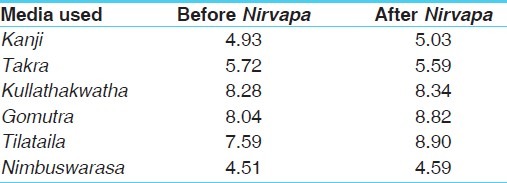
Results after Samanya Shodhana
Initial weight-245 g.
Final weight- 222.7 g.
Gain-2.7 g.
Results after vishesha Shodhana
Initial weight-222.7 g.
Final weight- 222.9 g.
Gain- 0.2 g.
Please note: After visheshaShodhana 10 g. sample was kept for analytical study.
Marana process of Rajata
Marana was done as per Rasa Tarangini[3] however, with a slight modification the method. (In the first phase, Kupipakwa process was done which was followed by the Puta process).
Preparation of Kajjali
Principle- Trituration
Materials required: Shuddha Rajata- 210 g., Shuddha Parada-420 g., Shuddha Gandhaka- 420 g., Gritakumari pulp - 350 g.
Equipments-Khalvayantra, spatula
Procedure- Mercury was taken in a stone mortar. Foils of Shuddha Rajata were cut into small pieces and taken in the above mortar and triturated till it was converted into complete amalgam. Shuddha Gandhaka was added to the amalgam and triturated till a black colored, shining, powder (Kajjali) was obtained. This was then followed by the Bhawana of Gritakumari Swarasa. It was triturated till Kajjali was dried.
Observations- The color of the mixture becomes black.
Results of preparation of Kajjali
Initial weight of Mixture- 1050 g.
Weight of Kajjali- 1030 g.
Loss of weight- 20 g.
Kupipakwa process
It was completed in 5 batches.
Materials required-Kajjali- 206 gm (in each batch),
Equipments required- Electric Muffle Furnace, Iron rod, beer bottle which was wrapped 7 times with a cloth smeared with multanimitti, cork.
Procedure-Kajjali filled Kach-kupi was kept in a vertical furnace and heated. Temperature was maintained in increasing order of Mradu, Madhya and Teevragni and the time was divided into 3 parts[Table 3, Graph 1].
Table 3.
Temperature pattern followed in Kupipakava

Graph 1.
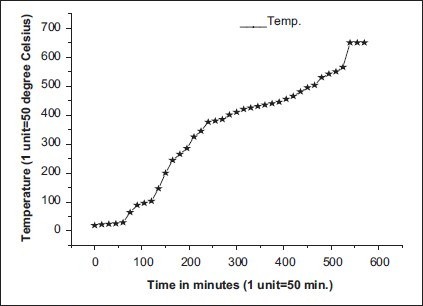
Temperature pattern in kupipakwa process
Observations
After around one and half hour, when the temperature was reached to 200 degree Celsius, yellow fumes were slowly liberated from the mouth of the bottle.
As the temperature increases, fumes become thicker.
At temperature of 530 degree Celsius, bluish yellow colored flames started coming out from the mouth of the kupi, and reached a maximum height of 3 inches as the temperature kept increasing.
Gradually the length of the flames shortened and they disappeared after 45 minutes.
Red hot iron rod was inserted into the mouth of bottle to clean any blockage.
When flames stopped, a copper coin was put on the mouth of the bottle. When fumes becomes free of sulphur, corking done. After corking, heat was given for around half an hour and Electric Muffle Furnace was switched off.
Breaking of the bottle
Next day when the furnace cooled down, the bottle was carefully taken out, cleaned and a kerosene soaked thread was wrapped below the neck of the bottle and burnt. When the flame subsided, small amount of water was sprinkled over the bottle, due to which the bottle broke. Sublime material (Rajata Sindura) was collected from the neck of bottle, and residue of partially prepared Rajata Bhasma was procured from the bottom of the bottle carefully.
Results of Kupi-paka process
The results of the Kupi-paka process are shown in Table 4.
Table 4.
Results of Kupipakva process in different batches
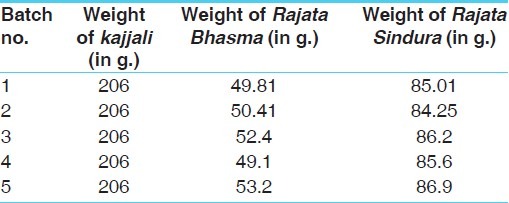
Puta process
After Kupi-pakva, the collected Rajata Bhasma was divided into 6 batches of equal weight. Marana of first 3 batches were done by conventional Puta method and another 3 through Electric Muffle Furnace.
Marana through Electric Muffle Furnace
Reference-Rasa Tarangini-16/26-28
Materials required – Partially prepared Rajata Bhasma obtained from the Kupi-paka–40 g., Hingula-4 g.(1/10th quantity of Rajata), Grita Kumari pulp-17 g.
Equipments required -Mortar and pestle, earthen casseroles, clay and cloth, Electric Muffle Furnace (EMF).
Procedure- Rajata was triturated with Hingula and Gritakumari Swarasa till a paste was formed. The paste was then dried and pellets were created. Sarava Samputa was done and it was kept in horizontal EMF. Temperature was allowed to gradually rise to 350 degree celsius in one and a half hour and maintained for 15 minutes. The furnace was then switched off and allowed for self cooling [Graph 2]. The next day, Sarava was taken out and pellets were again triturated with 1/10th of part Hingula and Grit kumari Swarasa. Puta was then given as above. In all, 5 Puta were given to obtain Rajata Bhasma of the desired quality. The results of the Putapaka have been depiced in Tables 5–7. Color of the Rajata Bhasma obtained was dark black.
Graph 2.
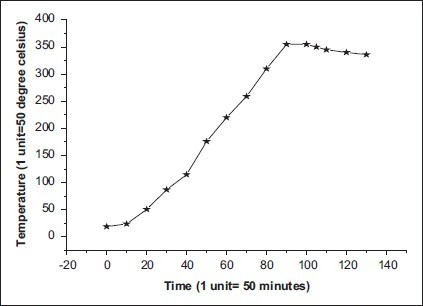
Temperature pattern in electric muffle furnace during Putapaka process
Table 5.
Details of Putapaka in batch.1
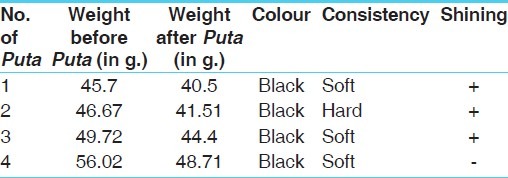
Table 7.
Details of Putapaka in batch.3
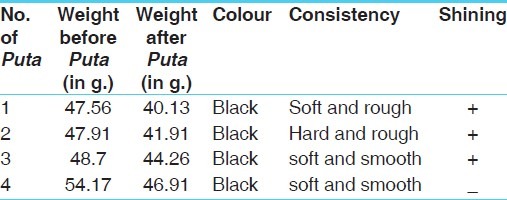
Table 6.
Details of Putapaka in batch.2
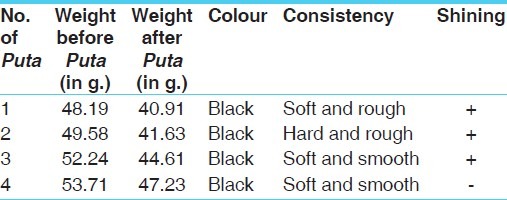
Marana process in conventional Puta
Reference - Rasa Tarangini-16/26-28
Method was same as in EMF except that heating was done by cow dung cakes, weighing 500 gm (Laghu Puta). Experiment was done in the month of May. It took 3 hours and 20 minutes time for the Puta to self-cool. The temperature pattern is depicted in Graph 3.
Graph 3.
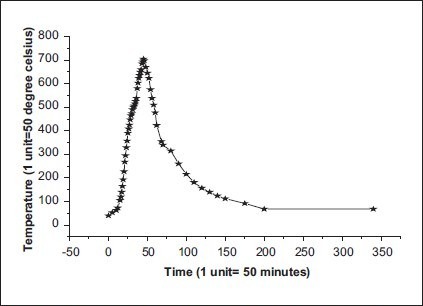
Temperature pattern recorded in conventional Puta
Observations and Results of Marana Process
Reason for the increase in weight after Marana- Weight of Rajata Bhasma was increased after each Puta because Rajata and other elements present in the intermediary material, reacts chemically with Hingula to form compounds, which in turn cause an overall weight gain. The results are summarized in Tables 8–10.
Table 8.
Details of Putapaka in batch no.-4
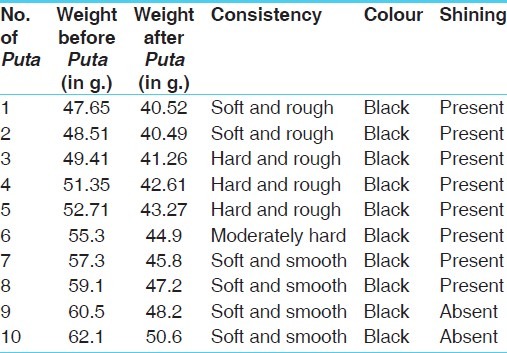
Table 10.
Details of Putapaka in batch no.-6
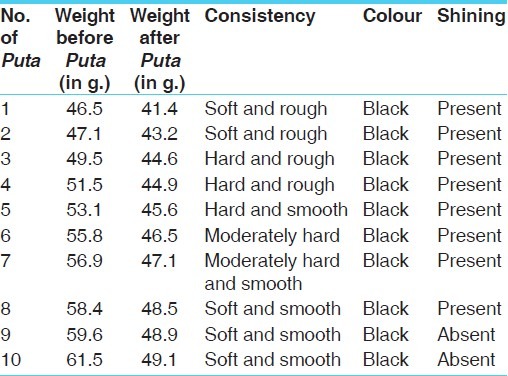
Table 9.
Details of Putapaka in batch no.-5
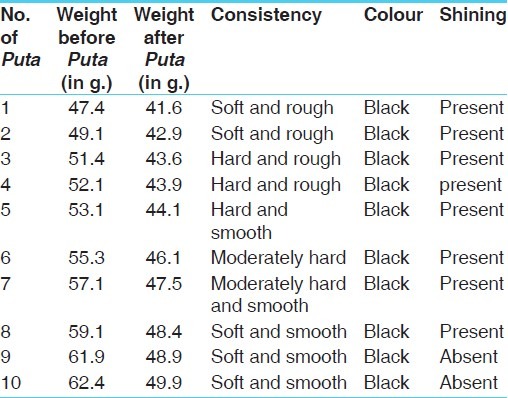
BhasmaPariksha
All the samples were subjected to the following tests-
Rekhapoorana- When small amount of Bhasma was taken in between the thumb and the first finger, and rubbed between them, it settled in the fingerlines.
Varitara- when Rajata Bhasma was sprinkled over a beaker filled with water, 80% of the particles floated on water.
Nishchandra- When Bhasma was exposed in sunlight, it was devoid of shining particles.
Mradutva- Bhasma was soft to touch.
Gatrasatva- Bhasma was tasteless.
Discussion
Shodhana and Marana are two essential steps in Bhasma preparation of metals. Shodhana detoxifies and makes material suitable for Marana. Heating till red hot and quenching in different liquids are the important procedures for Shodhana of metals. This process is also known as Nirvapa. On repeated Nirvapa, porosity develops in the Rajata foil, bonding between silver atoms becomes loose and some bonds are seen to break up. During the Nirvapa, inorganic and organic compounds present in liquids come in contact with hot foils of silver and dissociate due to high temperature (700 degree Celsius) and may react with silver atoms. Thus, few elements infuse with the silver atoms. When Nirvapa process is done further, many elements react with compounds of the medium used. As the process of Nirvapa is done 22 times in 6 different media, repeated chemical reactions take place. After completing the Shodhana process, Rajata foils were subjected to X ray florescence analysis. Reports clearly indicate infusion of Sn, Cd, Mg, K, Na, S, Ca, P, Si, Al, Cl, Ar, In, Fe, Cu, Ba, Hg, and Cr. These elements came from liquids used for Shodhana process. This may be the cause of increase in weight after Shodhana. As Patra became softer on repeated heating, it can be interpreted that the bonding between silver atoms became looser on successive Nirvapa process.
Marana is a compounding process. As per the medium used, Marana of metals can be done by using any of the four as follows: Rasa Bhasma; herbal extracts; Gandhaka and its minerals; and by Arilauhas. Amongst these, first three are used in daily practice. Marana with Arilauhas can be therapeutically harmful. Acharya Rasa Vagbhata has stated that mercury is best for Marana of metals.[4] Metals disintegrate when amalgumated with mercury. Due to this, the surface area of metals is widely enhanced, which facilitates the rapid compounding process. Thus, mercury acts as a catalyst in the compounding reaction and minimizes the time and labour. Due to these reasons, mercury was selected as medium for Marana of Rajata. Here, firstly Kupipaka heating was done. The product obtained was then subjected to Putpaka. On amalgamation of metal in mercury, the particle size was reduced and a fine powder was obtained. Hence, the surface area available for further incineration was increased. Kupipaka has its own advantages as Rajata Sindura can be procured as by product which has its own therapeutic uses. In the Kupipakwa process, a particular quantity of Gandhaka is utilized by the Rajata and other elements present in Kajjali. Mercury which forms mercuric sulphide is ultimately sublimated at the neck of the Kachkupi which is collected as Rajatasindura. Remaining amount of sulphur is destroyed.
With the help of mercury, best quality of Rajata Bhasma was produced. Partially formed Rajata Bhasma was subjected to Bhavana and Putapaka. Two or more materials get uniformly mixed in Bhavana, the size is reduced and certain medicinal properties are induced into it.
Many elements present in partially prepared RajataBhasma obtained from Kupipaka, react with the Hingula and Gritkumari pulp to form compounds. Due to this, gradual increase in the weight of Rajata is seen after every Puta.
Putapaka done in EMF, helped to achieve a better temperature control. Due to the variability of the cow dung cakes, the peak of the temperature obtained and the temperature pattern keeps changing, making it difficult to determine the exact number of Puta that will be obtained. Minimum 4 Putas are essential to obtain Bhasma of Rajata.
Conclusions
Mercury and sulphur together act as the best media in preparing Rajata Bhasma.
Kupipaka followed by putapaka is easy to follow and economical method. Here, can save time and labor, and also achieve best quality Bhasma.
Electric muffle furnace is better than conventional Puta heating due to controlled heating system.
References
- 1.Sharma Sadananda. Sanskrit commentary by Pandit Hari Datta Shastri. In: Shastri Pandit Kasinath., editor. Rasa Tarangini. 11th ed. 4-6. Vol. 15. Delhi: Motilal Banarasi Das; 1971. [Google Scholar]
- 2.Sharma Sadananda. Sanskrit commentary by Pandit Hari Datta Shastri. In: Shastri Pandit Kasinath., editor. Rasa Tarangini. 11th ed. 10-11. Vol. 16. Delhi: Motilal Banarasi Das; 1971. [Google Scholar]
- 3.Sharma Sadananda. Sanskrit commentary by Pandit Hari Datta Shastri. In: Shastri Pandit Kasinath., editor. Rasa Tarangini. 11th ed. 26-28. Vol. 16. Delhi: Motilal Banarasi Das; 1971. [Google Scholar]
- 4.Vagbhata . Rasa Ratna Samuchchya. 3rd ed. 14. Vol. 5. Delhi: Mehar Chand Lachman Das; 1982. commented by Kulkarni D.A. [Google Scholar]


